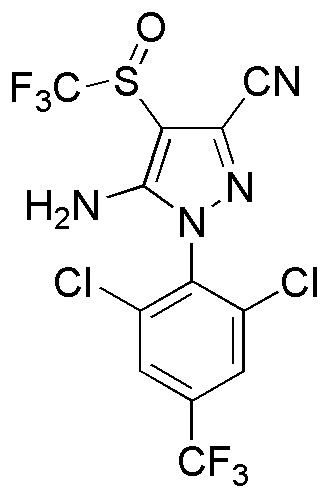Fipronil is widely utilized in research focused on:
- Agricultural Pest Control: Fipronil is a powerful insecticide used to manage pests in crops, particularly in the production of rice and corn. Its effectiveness against a wide range of insects helps farmers protect their yields.
- Veterinary Medicine: This chemical is commonly used in veterinary products to treat and prevent flea and tick infestations in pets. Its long-lasting effects make it a preferred choice for pet owners seeking reliable solutions.
- Termite Management: Fipronil is a key ingredient in many termite control products. It provides effective protection against these destructive pests, ensuring the integrity of wooden structures in homes and buildings.
- Public Health Insect Control: The compound is utilized in controlling disease-carrying insects, such as mosquitoes. Its application in public health initiatives helps reduce the spread of vector-borne diseases.
- Research Applications: In scientific studies, fipronil is often used to investigate the effects of insecticides on non-target species and ecosystems, providing valuable data for environmental assessments.
General Information
Properties
Safety and Regulations
Applications
Fipronil is widely utilized in research focused on:
- Agricultural Pest Control: Fipronil is a powerful insecticide used to manage pests in crops, particularly in the production of rice and corn. Its effectiveness against a wide range of insects helps farmers protect their yields.
- Veterinary Medicine: This chemical is commonly used in veterinary products to treat and prevent flea and tick infestations in pets. Its long-lasting effects make it a preferred choice for pet owners seeking reliable solutions.
- Termite Management: Fipronil is a key ingredient in many termite control products. It provides effective protection against these destructive pests, ensuring the integrity of wooden structures in homes and buildings.
- Public Health Insect Control: The compound is utilized in controlling disease-carrying insects, such as mosquitoes. Its application in public health initiatives helps reduce the spread of vector-borne diseases.
- Research Applications: In scientific studies, fipronil is often used to investigate the effects of insecticides on non-target species and ecosystems, providing valuable data for environmental assessments.
Documents
Safety Data Sheets (SDS)
The SDS provides comprehensive safety information on handling, storage, and disposal of the product.
Product Specification (PS)
The PS provides a comprehensive breakdown of the product’s properties, including chemical composition, physical state, purity, and storage requirements. It also details acceptable quality ranges and the product's intended applications.
Certificates of Analysis (COA)
Search for Certificates of Analysis (COA) by entering the products Lot Number. Lot and Batch Numbers can be found on a product’s label following the words ‘Lot’ or ‘Batch’.
*Catalog Number
*Lot Number
Certificates Of Origin (COO)
This COO confirms the country where the product was manufactured, and also details the materials and components used in it and whether it is derived from natural, synthetic, or other specific sources. This certificate may be required for customs, trade, and regulatory compliance.
*Catalog Number
*Lot Number
Safety Data Sheets (SDS)
The SDS provides comprehensive safety information on handling, storage, and disposal of the product.
DownloadProduct Specification (PS)
The PS provides a comprehensive breakdown of the product’s properties, including chemical composition, physical state, purity, and storage requirements. It also details acceptable quality ranges and the product's intended applications.
DownloadCertificates of Analysis (COA)
Search for Certificates of Analysis (COA) by entering the products Lot Number. Lot and Batch Numbers can be found on a product’s label following the words ‘Lot’ or ‘Batch’.
*Catalog Number
*Lot Number
Certificates Of Origin (COO)
This COO confirms the country where the product was manufactured, and also details the materials and components used in it and whether it is derived from natural, synthetic, or other specific sources. This certificate may be required for customs, trade, and regulatory compliance.


